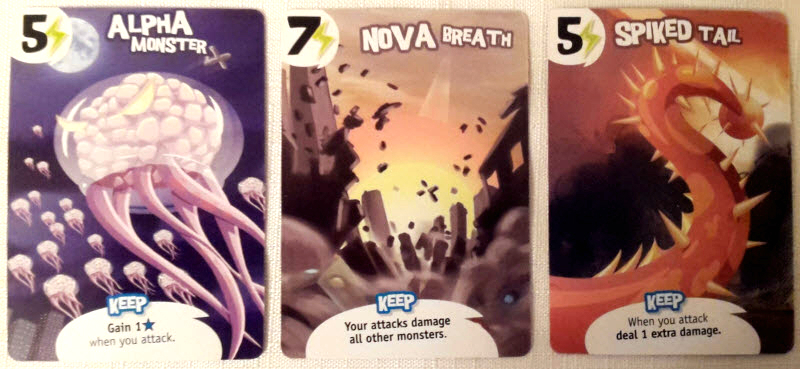Giant monsters have a knack for causing chaos and destruction wherever they go. We’d like to think that many of them cause such wanton destruction simply because their massive size makes it difficult to navigate the compact streets and congested skylines of our major cities, but we know better: they just like tearing up the place.
Admit it: if you were 200 feet tall, you probably would too.
For whatever reason, though, giant monsters have a love of Tokyo. Why they choose to congregate there instead of the many other wonderful cities they could be destroying remains a mystery, as the few reporters brave enough to attempt to ask have all been eaten. Until we know for sure, we suggest you give them plenty of space.
Also, you should probably pass on buying real estate in the downtown area too…
The Premise
The world’s assortment of huge mutated monsters, alien creatures, and giant robots have all converged in order to lay claim to Tokyo. Players must either eliminate their competition or simply hold out the longest in order to be the become the undisputed King of Tokyo.
The Rules
King of Tokyo is a fast and furious dice game about monsters looking to claim Tokyo. The game consists of a simple board with two locations: Tokyo City, which is the main spot monsters fight over, and Tokyo Bay, which works the same way but is only used in games with more than four players. King of Tokyo also consists of a pool of Energy cubes and a deck of Monster cards, of which the top three are revealed to begin the game.
Each player selects one of the available doombringers, such as the Meka Dragon or Kraken. Monsters have just two stats: Health and Victory Points. Monsters start with ten life and zero VP.
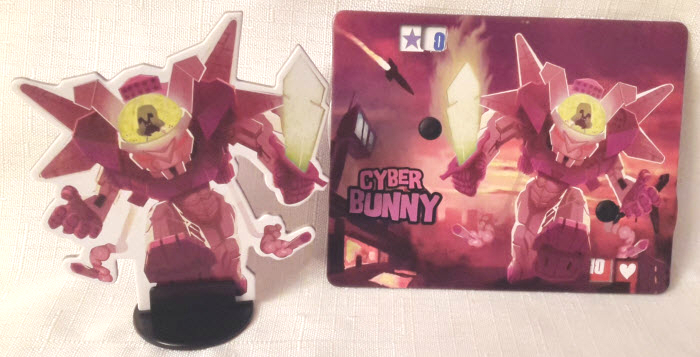
Bow to Cyber Bunny!
The game centers around rolling six custom black dice to enter and hold Tokyo for as long as possible, as there can only be one monster in a location at a time. To begin, each player rolls the dice. The person with the most Attack (claw) results is the starting player.
Turns in King of Tokyo are very simple. First, if the player begins their turn in Tokyo, they receive two VP. Next, the player rolls the dice and may reroll any number of them up to twice. Then, they resolve the results:
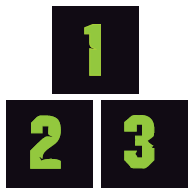 |
Victory Points: Three of the same number awards that much VP. (For example, scoring three 2’s gives two VP.) |
 |
Energy: For each Energy result, collect one Energy cube. |
 |
Attack: The player deals damage equal to the number of claw results. |
 |
Heal: For each Heart result, gain one health (up to a maximum of ten). |
If the player is currently “in Tokyo”, Heal results have no effect, and any Attack deals damage to each monster outside of the city. If, however, the player is not in Tokyo, Attack results are dealt to anyone in the city. After taking damage, a player in a Tokyo location may vacate the city; the attacker takes their place, earning one VP in the process.
Lastly, the player may then choose to spend Energy cubes to purchase Monster cards. Cards provide powerful one-time or permanent abilities. A player may buy as many Monster cards as they wish, and new cards are revealed to replace them. Alternatively, if a player doesn’t like any of the cards, they may spend two Energy to discard them and reveal three new ones.
Then the next player tries to eliminate the competition and claim Tokyo as their own.
If a player is reduced to zero HP, they are eliminated. Players take turns until only one monster remains alive or until someone reaches 20 VP. In either case, that player has clearly demonstrated that they – and they alone – are truly deserving of the pile of rubble that was once Tokyo. All other players are abject failures and must either bow to their new overlord, or find a new city to claim as their own. We do hear that London is nice this time of year…
Getting To Know Edo
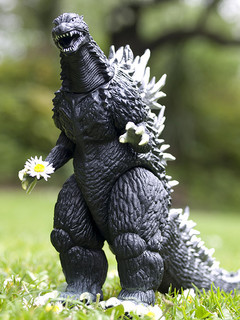
Can’t we all just live in peace?
If you had to pick one particular city that would be devastated time and again, look no further than Tokyo. Like New York is to Americans or Paris to the French, Tokyo is a cultural and socioeconomic hub of Japan. These cities aren’t just destinations for tourists and centers of commerce: they are also highly visible symbols of identity. These metropolitan locales are perceived as places of progress, resilience, tenacity, and the ideals of the people who make those places their home. In many ways, they are a condensed version of what their societies are all about.
So it kind of makes sense why humans have such an odd fascination when fictional events go about destroying them.
Disaster stories are hardly in short supply, though while the most famous American-made disaster shows and movies focus on the destruction of the entire planet (so that we can save it of course), Japan’s depictions long revolved around the atomically-infused aquatic monster, Godzilla.
Conceived in the post-war era, Godzilla emerged out of two very real events the country had to deal with: rebuilding Japan’s cities, and incredibly large concerns over the use of nuclear weapons. Godzilla (and the others kaiju he fought) evolved from there, but the premise remained that whether ally or enemy, Godzilla and pals always left devastation in their wake that people had to clean up.
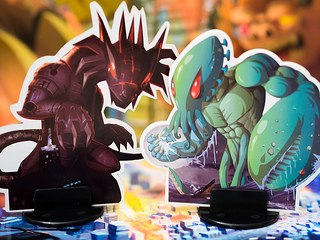
Mechagodzilla, meet Clash of the Titans.
Er, we mean Meka Dragon, meet Kraken….
For such a light game, King of Tokyo does a great job paying tribute to this thematic backdrop. Several of the monsters are even direct allusions to characters from the Godzilla franchise (or other well-known monsters of popular culture). Players merely choose whichever one they like best, taking on the personae of one of these giants who desire nothing more than to eliminate their competition, be it knockout or by amassing enough VP that the others capitulate and bow down to you as the alpha monster. Really, that’s pretty much the crux of the game. All of the dice rolling and spending Energy cubes funnel into the desire to reign supreme.
Human-Sized Troubles
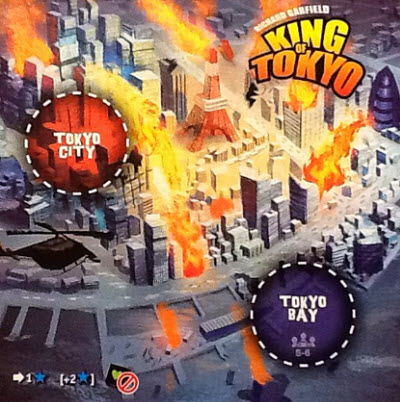
See the red spot? That’s all you need to know.
It’s surprising to note, then, that Immersionists will be on the fence with King of Tokyo, as the game’s theme is very surface-level. On the one hand, it has a small but varied monster pantheon, and there’s an impressive amount of flavor on the Monster cards. Unfortunately, since the game so quickly, you’re only likely to see a handful of such cards in a normal playthrough. Even the board of Tokyo itself is largely window dressing: it has no actual details to be concerned about and does nothing more than visually depict which monster(s) currently inhabits the city.
King of Tokyo’s theme resonates best when the dice are moving and players are in the throes of attacking one another over control of the city, but whether that’s enough for those who enjoy a substantively rich setting will be up to the player. Feel free to add in your own sound effects as you lay waste to your enemies, though. You are a giant monster after all…
More telling is the distinct lack of any monster traits. Although the game comes with a mechanical dragon, an alien, and more, The King plays exactly the same as the Cyber Bunny, making which monster you use entirely superficial. This keeps the complexity of the game low, but it also seems like a missed opportunity to add some unique characteristics while you’re ransacking the city. As a result, King of Tokyo doesn’t have much to offer Tacticians. There are some basic strategy choices to make, such as deciding when you should leave the city (or not) and which Monster cards to buy, but it’s not meant to be a highly cerebral game. Most monsters aren’t that complicated.

Similar reservations will come from Architects, as like other light games, King of Tokyo doesn’t provide the more passive approach to victory this group enjoys. (When you’re ten stories tall, there’s no such thing as being passive.) There’s also little to accumulate besides hoarding Energy cubes for the sake of it, and though amusing, that isn’t going to help you much.
Just Rolling With It
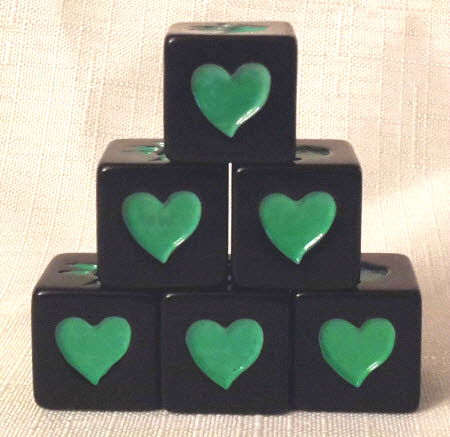
Six HP isn’t bad either.
Instead, King of Tokyo’s main focus is to be simple and engaging, with play times not lasting more than a half hour. King of Tokyo is the epitome of an Ameritrash Filler Game done well. It’s playable with a wide audience, from children and casual gamers to those looking for a fun exercise between heavier games.
It is an ideal game for Socializers due to quick turns and basic rule set, with minimal downtime between turns. It’s also ideal for Daredevils, as your turn revolves around the whim of the dice. You could go all Yahtzee and pummel someone for massive damage, or you could frantically reroll hoping for health to survive and not get a single Heart. The dice dictate this game and luck plays a huge factor, but with multiple opportunities to shoot for the results you really want, it’s hard for the gambler in all of us to resist.
The one caveat to the game’s accessibility is, oddly, the tactile experience of the dice themselves. The dice in King of Tokyo are larger than normal, making it pretty much impossible for most people to roll them all at once without using both hands. We get that it fits thematically – jumbo dice reflecting your role as a big ol’ monster – but using two hands every time tends to go against many people’s dice-rolling instincts. Practically speaking, the dice could be slightly smaller and still instill the same flavor.
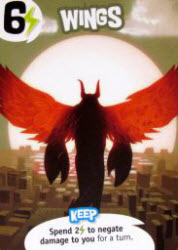
This will lift your chances.
That said, being a giant monster is anything but practical, and you have to approach the game with that mindset. King of Tokyo is not about making plans and executing successful strategies. It’s about yanking your enemy down from the nearest skyscraper and pummeling them into unconsciousness.
Strikers will appreciate the up-front attitude and simple premise King of Tokyo offers as they look to be the last creature standing. This enthusiasm will certainly be tempered, however, as Strikers often don’t enjoy games that are heavily reliant on luck – particularly dice rolling – to secure the win. Thus, some may still back away from this game, but for many others, King of Tokyo proves to be a worthwhile and notable exception as luck can be slightly curtailed between rerolls and taking advantage of useful Monster cards.
The Takeaway
King of Tokyo is undoubtedly in the camp of pure Ameritrash gaming, but it wears that title with oversized pride. Everything is bigger with King of Tokyo, from the giant city-destroying monsters to the dice themselves. Yet while the dice may be difficult for those with smaller hands to grasp all at once, the rules to the game are not (although the rulebook itself is unnecessarily cluttered). King of Tokyo is refreshingly simple, incredibly straightforward, and aims to bring out everyone’s inner Godzilla as they battle for control of the city. Everyone is encouraged to smash one another into the pavement, clawing your way to the top and asserting yourself as the undisputed King of Tokyo – although the dice often have the final say. Nevertheless, it has giant appeal in a small package. King of Tokyo stands out as a pinnacle example of what a makes for a successful filler game: it’s light, engages a wide audience, and its fast-paced nature keeps players wanting to come back for another bout.
King of Tokyo is a product of Iello Games.
Cardboard Republic Snapshot Scoring (Based on scale of 5):
Artwork: 3.5
Rules Clarity: 3.5
Replay Value: 4.5
Physical Quality: 4.5
Overall Score: 4.5
Photo Credits: Godzilla by Sebastian Dooris; Monsters clashing by Mikko Saari.

